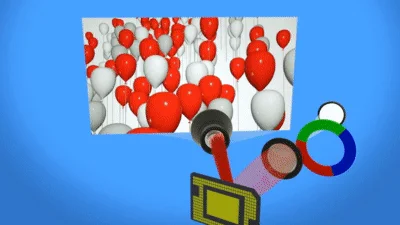What Is The Difference Between LCD and DLP Projector?
In modern life, projection technology has become ubiquitous, whether it is commercial demonstrations, educational training, or cinemas and theaters, projectors play an extremely important role. Among numerous projection technologies, LCD and DLP have become popular products in the market as two mainstream choices. They represent the innovative application of liquid crystal display technology and digital light processing technology, each with unique advantages and characteristics.
When purchasing projection equipment, have you ever been confused: Should I choose LCD or DLP projector? What are the similarities and differences between these two projectors? What are the advantages and disadvantages of each of them? Which projector is more appropriate for different scenarios? These questions can be confusing, but they are inevitable when choosing the right projection solution. In this next article, we will discuss LCD and DLP projector in depth to help you better understand them and make the projection choice that best matches your needs
Part A: Introduction of LCD Technology
- Working Principle
LCD (Liquid Crystal Display) uses a backlight layer to provide a light source to emit white light. The white light can turn into light of the corresponding color after passing through a colored color filter layer. When a voltage is applied to the positive circuit, it will penetrate the liquid crystal layer and connect to the negative circuit to form a loop. This voltage will drive the liquid crystal layer to deflect. At this time, the liquid crystal layer will block part of the light like a blind to prevent them from emitting. In this way, we can control the deflection angle of the liquid crystal molecules by controlling the voltage, thereby controlling the brightness of the red color. Similarly, the brightness of blue and green color can also be controlled in the same way. In this way, by changing the brightness ratio, you can mix the desired color.

- Advantage
- Excellent color representation: Simultaneous display of three primary colors, the final image has high color saturation, accurate restoration, and rich colors.
- Technology maturity: The technology maturity is relatively good. This technology has been developed for 30 years, and each product has undergone long-term application, optimization, and performance comparison.
- Low cost: Due to its simple structure, manufacturing process, and relatively low production cost, this technology greatly improves manufacturing efficiency and consistency, and also makes LCD displays competitive in price.
- Disadvantage
- Relatively low brightness: the brightness loss is large, and it is difficult to significantly increase the brightness of the product. Since the grid covering the liquid crystal surface blocks the transmission of light, most of the light is lost, seriously affecting the brightness performance of the LCD projector.
- Slow response time: When displaying rapidly moving images, blurring or dragging may occur. This will have a series of impacts on image quality, user experience, and professional field
- Limited viewing angle: LCD monitors have a relatively narrow viewing angle, and the viewer must be within a specific angle to get the best visual effect.
Part B: Introduction of DLP Technology
- Working Principle
The imaging principle of DLP is that the light source is decomposed into different colors of light through a color wheel. Then the light shines on the DMD™ chip, which contains thousands of tiny mirrors, each representing a pixel chip on the screen. The angle of each mirror is controlled based on the image signal to determine whether the light is reflected onto the projection lens. By quickly switching the angle of the reflector, a series of light pulses can be formed on the projection lens, presenting a complete image.
At present, there are three color wheels, four color wheels, six color wheels, and seven color wheels on the market. The more colors a color wheel has, the more dividing sections it will have, and the light loss will also increase. However, the imaging colors will be richer and brighter.


- Advantage
- High contrast and brightness: can achieve deeper black and brighter white, providing excellent contrast. The imaging method uses reflection, resulting in higher brightness than LCD. Being able to adapt to high brightness environments can also make images more vivid and provide better visual effects.
- Strong stability: DLP belongs to digital technology and is not affected by factors such as temperature and humidity. At the same time, the chip has a long service life, which can ensure that the image does not fade.
- No pixel gaps: Because the distance between lenses (between pixels) is very small, there is no mosaic phenomenon, resulting in a smoother and more continuous picture.
- Disadvantage
- Low color reproduction: Because its image is constantly changing through the color wheel, the primary color is output in time, and the colors are finally mixed by the human eye.
- Rainbow effect: When the color wheel rotates, the eyes move rapidly, causing different types of light to be perceived, resulting in colored bands appearing in the viewer’s eyes. The rainbow effect may be seen as a visual interference and may cause discomfort to some viewers.
Part C: Comparison
|
LCD |
DLP |
|
|
Pixel |
Strip |
Seamless |
|
Contrast Ratio |
Complex structure, requires three light sources to combine. |
Simple structure, single light source |
|
Sharpness (color alignment) |
Alignment issues persist |
No alignment issues |
|
Image Quality |
Slow switching, significant “lag” (tens of milliseconds), fast moving video smear |
Fast switching, minimal “lag” (a few microseconds), but possible color separation effects |
|
Durability |
Backlight source typically have a shorter lifespan and higher maintenance costs. |
The light source has a long life and low maintenance costs, but the bulb or light source needs to be replaced regularly. |
|
Image |
More vivid than DLP image |
Image color is not saturated |
|
Rainbow Effect |
No |
Yes |
|
Convenience |
Inconvenient to carry |
Lighter and easier to carry |
|
Light source |
Light bulb |
LED & Light bulb |
|
Technology Type |
Projection |
Reflection |
|
Application areas |
Family Entertainment |
Professional fields with extremely high image quality requirements |
Summarize
Through the detailed introduction and comparison of LCD and DLP technologies, we have a clear understanding of their respective characteristics, advantages and disadvantages. LCD technology has advantages in color performance and cost, while DLP technology has outstanding performance in image quality and contrast. When making a choice, we need to evaluate it based on actual needs. With the continuous development of technology, these two technologies are also constantly optimized and innovated. I hope that this article can help you have a deeper understanding of LCD and DLP technology and can make an appropriate choice based on your own needs.
If you are interested in knowing more about interactive projection systems, please follow us. We will share more helpful information on our blog. ZS Projector is a supplier who is offering interactive projection system from hardware to software. For a quotation please click quote, for most often questions please click FAQ, If you are interested in being our partner, please check to be our partner. Thank you very much and please share with others.

